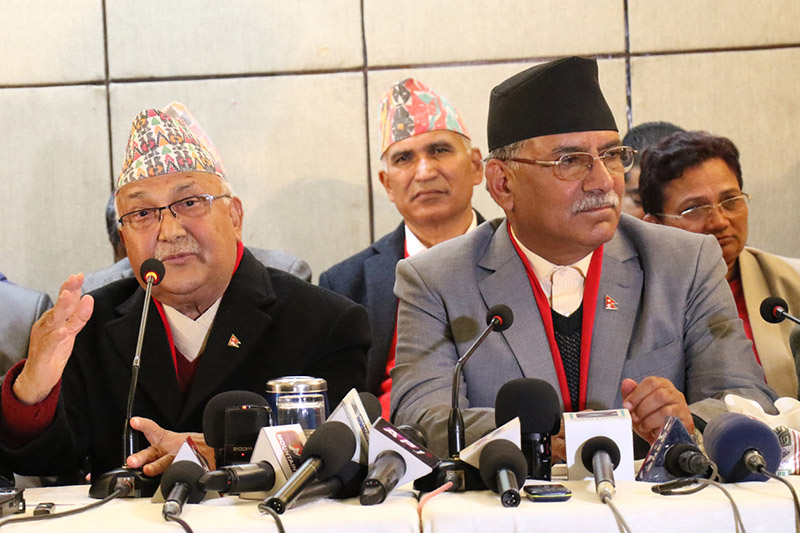Oli, Dahal likely to take turns in leading goverment
Oli will become the PM in the first phase, while Dahal will replace him in the second phase of the left alliance govt’s tenure
Kathmandu, December 18
Leaders of the left alliance have floated a proposal whereby CPN-UML Chairman KP Sharma Oli and CPN-Maoist Centre Chairman Pushpa Kamal Dahal would become the country’s prime minister on rotation.
The left alliance has secured comfortable majority to form the government, with the UML winning 120 seats and the CPN-MC securing 53 in the parliamentary elections that concluded on December 7. In the 275-member House of Representatives, 138 seats are required to form the government.
While Oli was elected to the Parliament from Jhapa, Dahal won from Chitwan.
According to the proposal, Oli would become the prime minister in the first phase, while Dahal would replace him in the second phase of the left alliance government’s five-year tenure.
Dahal has already announced publicly that Oli will be the country’s next premier.
UML Deputy General Secretary Ghanshyam Bhusal said Dahal could lead the Party Unification Coordination Committee while Oli heads the government, and vice versa. “There is no alternative to unification of the two parties,” Bhusal told THT. Stating that the joint statement released by the two parties while announcing the formation of the left alliance on October 3 mentions Oli and Dahal as ‘major leaders’, Bhusal said the two ‘major leaders’ would lead the government on rotation basis.
On the unification of the two parties, Bhusal said the left alliance would come up with a concrete road-map and modalities for unification by March.
Election results suggest that cadres of both the parties and the people have endorsed the idea of unification of the UML and the CPN-MC to form a single communist party, according to Bhusal. “They are now psychologically prepared and some form of unification has already taken place after the formation of the alliance and compact voting,” he said. According to Bhusal, the parties would form joint mechanisms at the central, provincial, district and municipal-levels, such as road user group and forest user group, which would the party cadres together.
“The government and the parties will have a common programme, which will be implemented by the joint mechanisms,” he said. “After that we will hold a general convention and unite the party.”
“The left alliance is an outcome of the UML’s realisation that it would lose if the CPN-MC and the Nepali Congress went to polls together, and the CPN-MC’s realisation that it is more rewarding to forge an alliance with the UML than with the NC,” a senior UML leader told THT. “Leaders wanted the alliance before the polls, and now cadres and public also want parties’ unity.”
According to CPN-MC Spokesperson Pampha Bhusal, people have endorsed the idea of unification of the two parties so the processes of formation of the government and party unity will move ahead simultaneously. CPN-MC leader Agni Sapkota said the unity coordination committee would soon draft a schedule of work to ensure parties’ unity.






